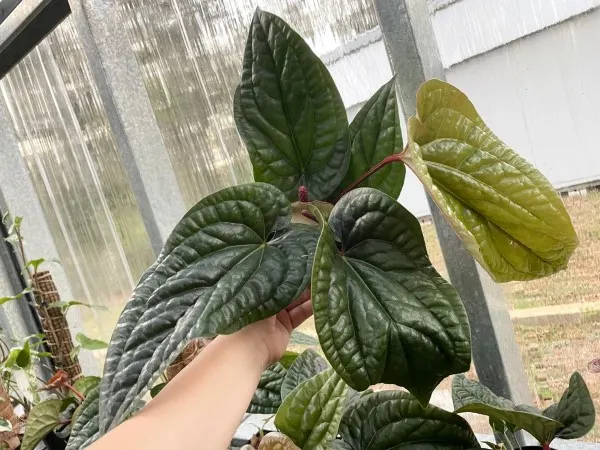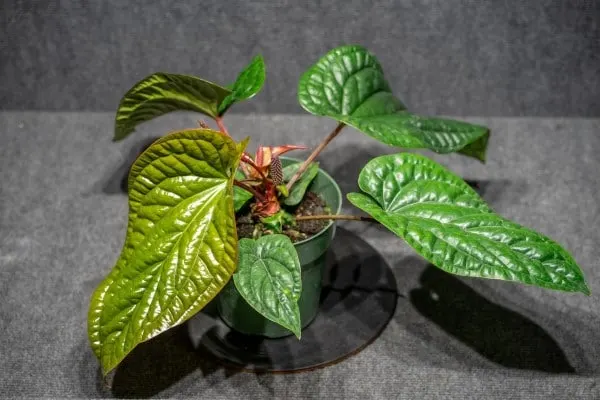Anthurium Radicans, also known as Anthurium Malyi, is an excellent perennial tropical plant that can light up the whole environment of your room.
You can use them anywhere; whether it be your garden or room, these plants will adjust almost anywhere due to their average growth height and spread.
The leaves of these plants are the main highlight; however, the flowers can also be seen to intensify the beauty. The Inflorescences are often seen in the form of the spadix, similar to other Anthuriums.
Anthuriums are the largest genus of the Araceae family. These plants belong to the Anthurieae tribe, which has more than 1000 other species that produce unique flowers.
Most of the plants are terrestrial, the ones that grow on land, but the Anthurium genus also produces epiphytic plants, which grow on other trees and plants.

Characteristics of Anthurium Radicans
These plants have some of the most iconic characteristics that make them plant lovers’ favorite. Some of the most captivating ones are listed below.
Foliage
The dark green color of the leaves fits perfectly above the long glossy stems of the plant. The leaves are bullate and caudate-shaped. You can see more than one stems growing from the same base, which further gets separated by individual leaves.
Flowers
The flowers are of multiple colors grown spirally on the spadix. The colors are pink, maroon, or purple, which remain there throughout the year.
These plants never run out of flowers as they produce a new one as soon as the previous one falls off. The average age of the flower is around two to three months.
Evergreen
These plants are evergreen, so do not worry about their leaves losing their mesmerizing foliage with changing seasons. You can enjoy you’re the mesmerizing foliage of your sensational plant throughout the year.
Height and width
They can reach a maximum height of 15 to 20 inches indoors; however, the size of the plant can be increased if you provide it with a good climbing medium.
Origin
They were first found in 1854 in the rainforests of Brazil and Ecuador. We recommend keeping them under similar environmental conditions to their native lands to get the best out of these plants.
Toxicity
These plants are highly toxic. Consuming the leaves can cause diarrhoea, ulceration of the mouth, and nausea. Please keep your kids and pets away from these plants.
Drought tolerant
They are drought-tolerant, so you can leave them without water for days and they will still survive. Stems of the plant can store the water for future use, allowing the plant to stay healthy if the conditions are too dry.
Low maintenance
These plants will not be too heavy on your pocket. They can thrive with minimal care and attention, making them a must-have plant for your home garden.

Caring tips for Anthurium Radicans
Sunlight
A 70 to 85 percent bright light is required for these plants to thrive, but make sure that they are protected from direct sunlight. Exposing them to harsh sun rays for a long time can harm the foliage, and it will lose its shine.
Soil
Grow these plants in slightly acidic soil with a pH range of 6.1 to 6.5. Take a combination of perlite, sand, and orchid mix to produce an ideal soil mix for your plant. Organic matter helps improve the aeration and drainage of the soil.
Water
Water the plant once a week, depending upon the soil situation. They do not require a lot of watering, and overwatering them can damage the roots, so always check the soil if it’s dry or moist before watering the plant again.
The summer season requires more watering than winter because of the dormancy period. These plants do not grow in the winter season; thus, watering them would be unnecessary.
Temperature
Maintain a warm stable temperature between 21 to 32 degrees Celsius. If kept under temperatures lower or higher than this range, they cannot survive for long. Move them inside in the winter when the climate is too cold for the plant to resist.
Humidity
60 to 80 percent humidity is required for ideal growth; however, they can survive in normal household humidity. We recommend increasing the humidity levels by placing a pebble tray with water below the plant or misting the leaves to increase moisture.
You can also use a humidifier, which is the most efficient but expensive at the same time.
Fertilizer
They do not need a lot of feeding for perfect growth, so fertilize them with a slow-release phosphorus fertilizer thrice a year. Feed them in the growing season for more blooms and boost growth speed.
Pruning
Prune the plant to remove any dead leaves. It also helps improve your plant’s health by protecting it from various diseases. If left untouched, these plants can look unappealing, so maintain their shape by pruning them when required.
Pests and other diseases
These plants do quite well against pests and other diseases but can still get infected if not taken care of properly. Spider mites can attack your plant to damage its foliage, so use insecticidal soap or spray to protect them.
Propagating Anthurium Radicans
You can use stem cuttings for propagation. Following are some tips to propagate your Anthurium Radicans.
- Choose a stem that is at least 6 inches long with a couple of leaves attached to it.
- Make a cut a few inches below the leaf node, ensuring that the leaves above the stem remain intact.
- Treat the cut with a rooting hormone and water to develop the roots faster from the cutting area.
- Place the cutting in the soil and water it more in the first few weeks of growth.
- Place the plant under bright, indirect sunlight.
- Make sure to keep the soil moist but not soggy.
Conclusion
Anthurium Radicans is an exceptional plant that can make your garden look like a mini tropical rainforest. So please provide them with ideal conditions to grow and enjoy the beautiful foliage for a long time.
